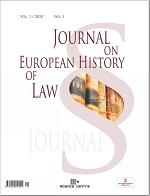Consequences of the Changing Migration Model after the World War I.Hungarian Legal Manoeuvres for Regaining a Blocked Tool in the USA
Consequences of the Changing Migration Model after the World War I.Hungarian Legal Manoeuvres for Regaining a Blocked Tool in the USA
Author(s): Balázs PálvölgyiSubject(s): Law, Constitution, Jurisprudence
Published by: Evropská společnost pro právní dějiny, z.s.
Keywords: Hungary 1920-1940; migration; Hungarian refuge house New York; legal case.
Summary/Abstract: Before World War I Hungary built up a functioning subvention system, ensuring influence on and control over the Hungarian migrant groups. In the framework of this migration policy the government transferred amounts through the consul general and the Hungarian Mutual Aid Society for the creation of a Hungarian refuge house in New York. After the lost war, given the new international conditions and together with the lack of funds there was no reason to maintain the subvention system for the Hungarian migrants, coupled with the financing of the pro-Hungarian movements and organizations in the USA. The block of migrant routes, followed by the Quota system, cut the migrant flow from Hungary to America, therefore the Hungarian government had to rethink its migration policy as well. Because of the American legal framework the Hungarian government provided a loan and monetary aid in a semi-official way for the purchase, the Hungarian refuge house was in theory the propriety of the Hungarian Mutual Aid Society. Therefore, its process leading to the sale of the house in the 1920s triggered an intensive reaction on the part of the Hungarian government, which launched a series of legal manoeuvres in order to recover it for the Hungarian state.
Journal: Journal on European History of Law
- Issue Year: 3/2012
- Issue No: 2
- Page Range: 159-164
- Page Count: 5
- Language: English

